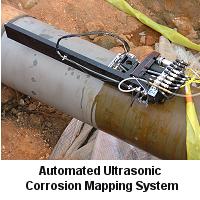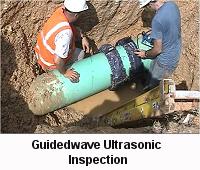1550 Cobb Industrial Dr. | P.O. Box 9098 | Marietta, GA 30065-2098
770-425-1355 (Phone) | 770-425-1354 (Fax) | info@alliedcorrosion.com (Email)
©2018 Allied Corrosion. All rights Reserved.
Made with ❤ by Mighty Good Marketing
Internal Corrosion Direct Assessment (ICDA) is a process designed to gauge internal corrosion and its impact on natural gas pipelines, and other transmission pipeline systems. An intricate part of Pipeline Integrity Management is the verification that internal corrosion does not exist in your transmission pipeline system. Our field-proven pipeline Direct Assessment specialists effectively combine the internal corrosion direct assessment process with other corrosion assessment processes, providing a complete and cost effective pipeline integrity management program. Allied Corrosion has assembled an experienced staff of proven Direct Assessment professionals, along with investing in state-of-the-art equipment required to identify and assess potential internal corrosion locations on dry gas transmission pipelines. Our direct assessment staff consists of NACE certified Corrosion Specialists, Cathodic Protection Specialists and Internal Corrosion for Pipeline Technologists.
Dry Gas- Internal Corrosion Direct Assessment (DG-ICDA): As defined in the NACE Standard SP0206-2006 Dry Gas Internal Corrosion Direct Assessment (DG-ICDA) for gas lines is a detailed examination of locations along a pipeline where liquids could first accumulate, allowing inferences to be made about the integrity of the remaining downstream length of pipe. The DG-ICDA process consists of four steps:
The pre-assessment phase requires historical and current data collection, which is used to determine feasibility and identify regions for DG-ICDA. To minimize the interference with the operator's day to day operations, we normally provide a list of the minimum data elements required, along with a list of additional data elements requested if available. The actual collection of data, though normally performed by the operator, can be performed by our staff if requested.

Utilizing sub-foot accurate GPS and a depth recording digital pipe locator, all connected to a data logger utilizing Utilimapper software, a pipeline elevation profile is created from data collected over the operator´s pipeline. This data, in conjunction with the multi-phase flow modeling calculations determined by our liquid hold-up software is presented in both graphical and tabular form.


The objective of the direct examination step is to identify three consecutive potential liquid hold-up locations that are free of internal corrosion. The best case being, that no internal corrosion is found at the first three locations examined. The direct examination is accomplished by excavating the pipeline at predetermined intervals along the entire segment identified as a potential liquid hold-up location. Utilizing Long Range Guidedwave Ultrasonic equipment, the pipe segment between excavations is inspected for anomalies. All anomalies indicated by the GUL inspection are then excavated and examined utilizing our Automated Ultrasonic Corrosion Mapping System.
This system provides documented results verifying the existence or nonexistence of internal, midwall, or external anomalies. It performs the inspection using raster scan technology at sample intervals as fine as every .04 of an inch with speeds reaching 10 inches per second. In addition to examining the condition of the pipeline at each excavation, our pipeline integrity management team can design and install internal corrosion monitoring systems, ranging from permanently installed GUL transducer belts to coupons. These types of installations can ultimately save the operator large expenditures in excavation cost.

The objective of this step is to determine the effectiveness of the whole DG-ICDA process and to determine reassessment intervals. Utilizing all of the information collected throughout the entire process, we can provide the operator with written documentation discussing the functions performed during each step of the DG-ICDA methodology. The effectiveness, along with suggested improvements to the applications of DG-ICDA are included in this documentation.
Our Pipeline Integrity Management Staff is ready to provide turn-key DG-ICDA services or any portion of the methodology an operator requires. Our goal is to provide you with the highest quality of professional customized Direct Assessment Services that you require. We are available to meet all of your DA needs. Please contact one of our Pipeline Integrity Management Specialists to discuss how we can assist you in meeting your requirements.
Our strong understanding of the potential destruction from a compromised pipeline allows us to deliver detailed DG-ICDA to complement any operator's Integrity Management program. Our comprehensive pipeline integrity and cathodic protection engineering services will keep your pipeline assets protected throughout its life-cycle.

Contact Allied Corrosion Today
1550 Cobb Industrial Dr. | P.O. Box 9098 | Marietta, GA 30065-2098
770-425-1355 (Phone) | 770-425-1354 (Fax) | info@alliedcorrosion.com (Email)
©2018 Allied Corrosion. All rights Reserved.
Made with ❤ by Mighty Good Marketing
1550 Cobb Industrial Dr. | P.O. Box 9098 | Marietta, GA 30065-2098
770-425-1355 (Phone) | 770-425-1354 (Fax) | info@alliedcorrosion.com (Email)
Made with ❤ by Mighty Good Marketing
Primary voltage range for material
Voltage range in crevices or stagnant and poorly aerated water
We care about your privacy! In order to run a successful website, we are setting cookies and accessing and storing information on your device for various purposes. By continuing to browse this site, you are agreeing to our use of cookies.
If you wish to disable cookies, please visit our Privacy Policy for more information.